
Reuters/Jon Herskovitz
Campaign signs concerning a municipal vote over fingerprint requirements for ride-hailing companies such as Uber and Lyft are seen along a roadway in Austin, Texas, May 6, 2016.
A recent study from the University of Michigan
Uber and Lyft left Austin, Texas in May 2016 after servicing the city since 2014. The ridehailing giants called it quits after voters upheld strict regulations on the companies, like issuing fingerprint-based background checks.
Uber and Lyft returned in May after lawmakers passed a bill overriding the strict regulations.
The departure offered a unique window of opportunity for researchers to investigate how people changed their habits after growing accustomed to ride-hailing services.
The study surveyed 1,200 Austin locals and asked what trips they typically took using an Uber or Lyft. It then asked how they were making those same trips now that the ride-hailing services weren't available.
The study found that 41% switched back to their own cars to fill the void left by Uber and Lyft. Among the people who turned back to their own vehicles, 9% bought an additional car strictly for the purpose of getting around without the ride-hailing giants.
From there, 42% of people surveyed switched to another ride-hailing company in the area. A flurry of community-based services and smaller apps entered Austin in the wake of Uber and Lyft's departure, such as Arcade City Austin.
Only 3% of participants surveyed said they turned to public transit.
The takeaway isn't so much that Uber and Lyft reduce the need to own a car, but rather they limit how often people use a car they already own, Robert Hampshire, lead author of the study, said in an interview.
"A large faction of these people already had a car and just weren't using it as much," he said. "Then when Uber and Lyft left, they began to use it more often."
Still, it's noteworthy that roughly 100 people felt the need to buy a car without the presence of a major ride-hailing service. Additionally, people who switched to their personal vehicle were 23 times more likely to report making more trips than those who switched to a community-based service like Arcade City Austin.
"What I thought stood out the most was for those who did switch to their personal vehicle, they drove considerably more often," Hampshire said.

Kelly Sullivan/Getty Images
Having to weigh the cost of each individual ride may encourage people to take fewer trips, Hampshire said. Most people don't think about how much they drive after purchasing a vehicle outright.
That could be good news for major cities, which are grappling with worsening congestion. If people feel compelled to only take a Lyft or Uber when it's absolutely necessary, that reduces the number of cars on the road. In a small number of cases, the services' presence could compel someone to forego purchasing a car altogether.
Hampshire said he was surprised by how few people opted to take public transportation.
"In Austin, their public transit system is not as built out as other cities. It may not be seen as a viable option," he said.
Automakers are preparing for the death of car ownership in cities. General Motors launched in 2016 its car-sharing service called Maven. Maven is primarily used by millennials who may be reluctant to own a car in expensive cities like New York and San Francisco.
Although the study bodes well for traffic relief, it's worth taking it with a grain of salt.
Ditching a personal car in favor of ride-hailing apps can help alleviate traffic if done on a wide enough scale. But unless more people start to rely on carpool services like Lyft Line or UberPOOL, ride-hailing still contributes to more single-occupancy cars on the road.
Hampshire said of the people surveyed who used Uber and Lyft as their primary method for getting around, only 12% elected to use the companies' carpool options.
The study's results may also vary in cities that have better access to public transportation.
Either way, the study shows ride-hailing can make it easier to ditch personal cars in large cities.